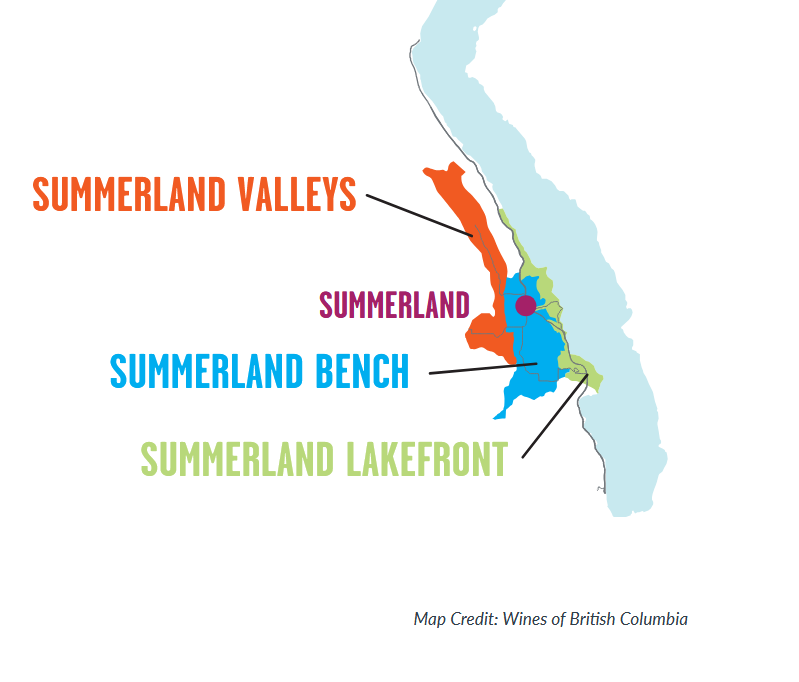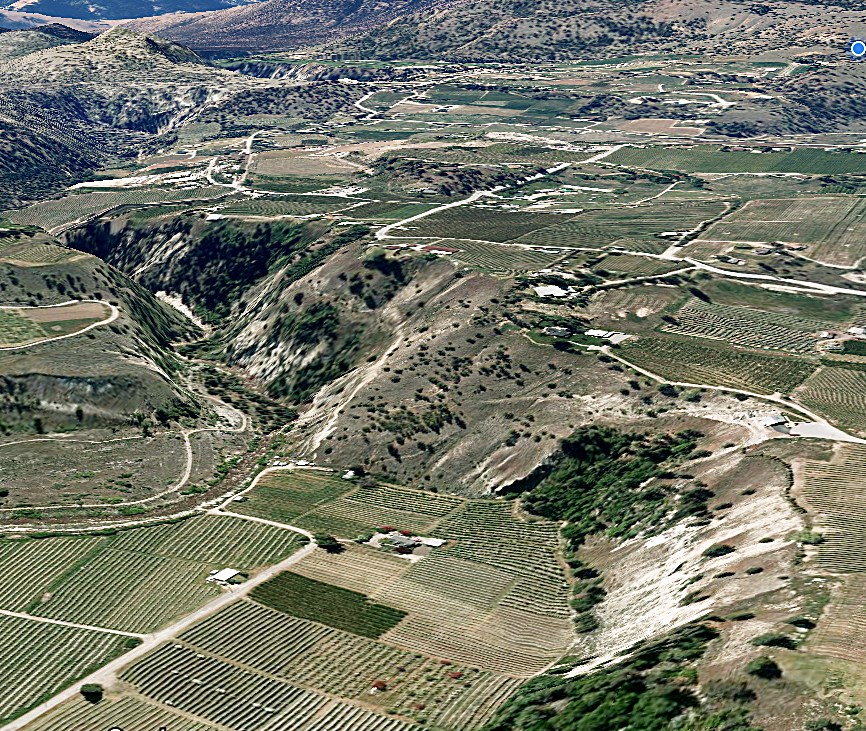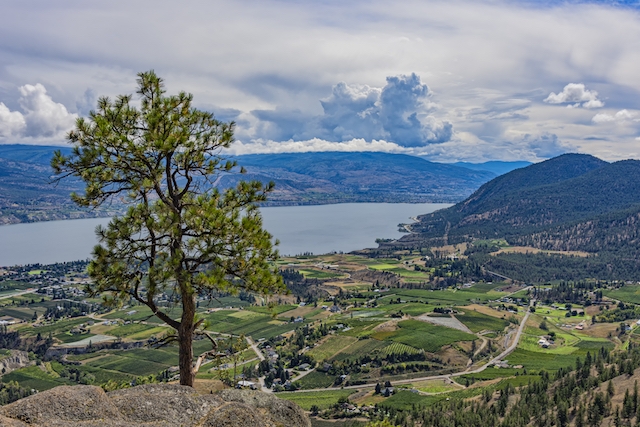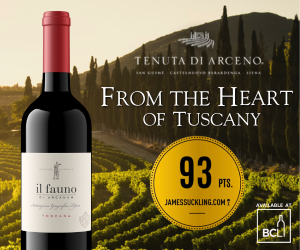In our ongoing series on British Columbian pinot noir, Summerland is the focus this month.
The area was split into three sub-GIs, so we looked at each sub-region in detail: Summerland Lakefront, Summerland Valleys, and Summerland Bench, the latter being today's focus. You can read the Lakefront article, which includes an overview of the town of Summerland and the region as a whole.
Summerland Bench sub-GI

Most of the Summerland Bench sub-GI lies sandwiched between the other two sub-GIs, East of the Southern portion of Summerland Valleys and West of Summerland Lakefront. Most vineyards are in the East and South of Giant's Head Mountain area. The total area of the Summerland Bench sub-GI is 1800 hectares, though much of it is non-arable or urbanized land. The southern edge of the sub-GI is the escarpment overlooking the Trout Creek Canyon.

The Summerland Bench sub-GI landscape is marked by undulations and terraces formed in the geological past when large volumes of glaciofluvial flows (glacial meltwater) carved out canyons and deposited gravels to create the varied terrain that surrounds Giant's Head Mountain. These forces produced an array of sediments that form the parent materials for the soil types utilized in viticulture today. The sub-GI receives 1334 growing degree days on average per year. This will vary according to elevation. However, the average makes the sub-GI cooler than the South Okanagan, where growing degree days (defined as temperature being over 10 Celsius) can be closer to 1500. On the other hand, it is a warmer sub-region than the vineyard areas in Kelowna and farther north in Lake Country and beyond.
Vineyards
At 1800 hectares, the Summerland Bench is the largest of the Summerland sub-GIs. Still, several volcanic bedrock masses, including the centrally located Giant's Head mountain and the Summerland townsite area, occupy a large percentage of this area. This leaves only about 800 hectares of arable land, with few wineries and vineyards in the central part of the district. Five hundred hectares of agricultural land are located south of Giant's Head Mountain at 430 to 600m elevations. The other 300 hectares of more level land lies north of downtown Summerland at about 500m elevation. Vineyards cover only a relatively tiny portion of this agricultural land, about 70 hectares.
The vineyards experience a range of climatic conditions determined by elevation, aspect, and topography. Most of the soils are coarse-textured and well-drained. Overall, the slopes in the vineyard sites are gentle and lie several hundred meters higher than one to three kilometres back from Okanagan Lake.
The situation, climate and aspects of the Summerland Bench sub-GI suit Pinot Noir very well. Two-thirds of the red varieties planted here are pinot noir. Two of the eight wineries that produce pinot noir in Summerland Bench are on the northern tip, very close to the other Summerland sub-GIs. However, pinot noir's sweet spot is close to the Southern boundary, with six wineries occupying a plateau whose edge describes the steep valley and outwash delta of Trout Creek. Three of these wineries hug the boundary with Summerland Lakefront, highlighting the importance of soil type variation in delineating the three Summerland sub-GIs.
The wineries making pinot noir located in Summerland Bench sub-GI include Sumac Ridge Estate Winery, Back Door Winery, Dirty Laundry Vineyard, Lightning Rock Winery, Giant Head Winery, Lunessence Winery & Vineyard, Thornhaven Estates Winery, and Silkscarf Winery. In my opinion, the two most noteworthy pinot noir-producing wineries in this sub-GI are Giant Head Winery and Lightning Rock Winery.
Giant Head Winery
For those who become enraptured with pinot noir, an "epiphany bottle" is often the beginning of the love story, a great bottle that captivates, entrances, and leads on. In the case of John Glavina and Jinny Lee, the owners of Giant Head winery, a Gevrey-Chambertin Le Clos St. Jacques tasted on holiday to France in 1998, set in motion the wish to have their own vineyard. Subsequent tours of Willamette Valley wineries over the years deepened their appreciation of pinot noir.
In 2004, they purchased an apple orchard on a bench in the skirts of 500-meter-tall Giant's Head Mountain, a prominent feature of Summerland's complex geography. In 2006, they planted four acres of their own-rooted vines, including pinot noir.
John, with a degree in computer science and a technical background, focuses on winemaking, while Jinny, an electrical engineer by training, farms and manages the vineyard. Their first commercial vintage was in 2014, and their winery opened in 2015.
Their primary focus is to make wines from their estate vineyards. Over the years, they have released three different pinot noirs, including a Reserve and a Select. However, in 2016 and 2017, they had access to pinot noir grapes from the celebrated Canyonview Vineyard, which they released under their Canyonview label.
Lighting Rock Winery
Lightning Rock Winery began with the passion and expertise of winemaker Jordan Kubek and her vineyard manager husband Tyler Knight. Jordan came to the Okanagan in 2010 to complete her winemaking training, working the harvest at Stoneboat Vineyards. She then joined Okanagan Crush Pad (now Haywire), where she met Tyler. She eventually became the sparkling wine specialist there. Tyler, along with Jordan, did harvests in New Zealand, Australia, and the prominent Chilean winery Clos des Fous and spent much time in several European wine regions.
Their dream of having their winery was enabled in 2016 when Jordan's father, Ron Kubek, purchased two vineyards in the Summerland Bench sub-GI. The home vineyard, Elysia, was planted in 2006 and purchased in 2017. It includes 1.4 hectares of pinot noir on an elevated, eastward-facing, granitic hill containing alluvial soil and limestone.
From the beginning, under Jordan Kubek, the winemaking focused on producing minimal intervention but unfaulted wines. This included starting with "pied de cuve" from grapes in the vineyard as a starter, adding low sulphur, using a mix of fermentation vessels, and farming using organic practices. The winery's first vintage was in 2017.
The second vineyard, purchased in 2018, was the celebrated Canyonview vineyard, begun by Krimo Souilah in 2003. It contains 1.6 hectares of pinot noir that, over the years, has made notable wines for several wineries. Okanagan Crush Pad made single vineyard designated wines with Canyonview pinot noir grapes up until the 2015 vintage. Giant Head Winery made pinot noirs from the vineyard under their Canyonview label in 2016 and 2017. The first vintage of Canyonview at Lightning Rock was in 2018.
A third vineyard, St. Katharina, planted in 1968 and located in the Summerland Valleys sub-GI, was later added to the mix. It is one of the first vineyards in the Okanagan to be planted with pinot noir.
In part to pursue their enthusiasm and commitment to making natural wines, Jordan and Tyler moved on from Lighting Rock in 2023 to begin a new winery project. The Pamplemousse Jus winery is located near the Summerland Valley sub-GI and utilizes grapes from the St. Katharina vineyard.
Lightning Rock's current winemaker Sébastien Hotte, is a Washington State University graduate and a certified sommelier who continues the winery's focus on low-intervention winemaking.

 quicksearch
quicksearch






